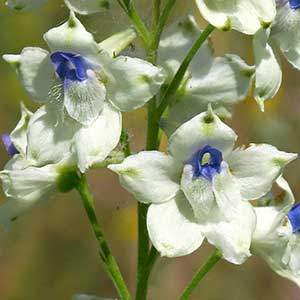Delphinium nuttallii subsp. ochroleucum
(synonym of Delphinium leucophaeum)
Delphinium newtonianum
pale larkspur, white rock larkspur
newton's larkspur, Ozark larkspur
30-60 cm.
40-90 cm;
base often reddish, puberulent.
blade round to pentagonal, 4-7 × 5-15 cm, nearly glabrous; ultimate lobes 3-7, width 8-20 mm (basal), 5-15 mm (cauline), widest at middle or in proximal 1/2.
8-20(-40)-flowered, as wide as long or nearly so;
pedicel 1-4(-6) cm, pubescent;
bracteoles 6-15 mm from flowers, green, linear, 1.5-5 mm, puberulent.
sepals white or light yellow, spurs 9-11 mm;
lower petal blades 4-6 mm.
sepals dark to light blue, rarely white, glabrous, lateral sepals spreading, 12-14 × 6-7 mm, spurs straight to decurved, within 30° of horizontal, 10-15 mm;
lower petal blades slightly elevated, ± exposing stamens, 4-5 mm, clefts 2-3 mm;
hairs mostly centered near base of cleft, yellow.
8-12 mm, 3-3.5 times longer than wide, nearly glabrous.
unwinged;
surface of each seed coat cell with swollen, blunt, hairlike structures, barely visible at 20x, otherwise smooth.
= 16.
Delphinium nuttallii subsp. ochroleucum
Delphinium newtonianum
Of conservation concern.
The range of morphologic features of Delphinium nuttallii subsp. ochroleucum (D. leucophaeum) is almost completely encompassed within that of D. nuttallii subsp. nuttallii. Sepal color is the only feature consistently separating the two subspecies. Were it not for the fact that any given population typically has plants of only one flower color, a rank of forma would be more appropriate.
(Discussion copyrighted by Flora of North America; reprinted with permission.)
No cases of hybridization are known. Delphinium newtonianum often occurs in mixed populations with D. tricorne. It normally does not begin flowering until 4-6 weeks after D. tricorne has finished.
(Discussion copyrighted by Flora of North America; reprinted with permission.)


